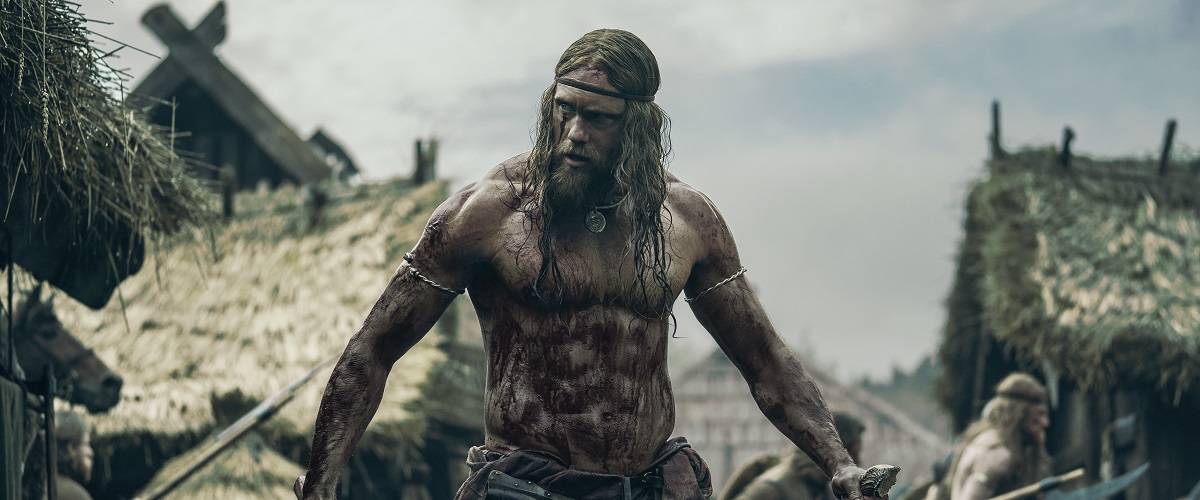Movie Info
Movie Info
- Director
- Robert Eggers

I wish I could join the critics hailing Robert Eggers’ carefully researched Viking epic as a “Masterpiece,” but I came away repulsed by the bloody brutality that it seems to celebrate. Co-written with Icelandic poet Sjón, this 10th century Viking saga affirms the pagan values that impel a man in search of vengeance to descend to a level of violence beneath that of any known beast. There is one long scene in which our hero faces off with the villain, each of them naked and snorting, bellowing, and farting before going at each other with shield and sword. The Viking myth this is based on might have inspired Shakespeare’s Hamlet, but there is not a trace of eloquence in the sparse dialogue of the screenplay.
Also, there is never a moment of “To be or not to be” in the case of the hero Amleth, who as a boy witnesses, before escaping, the attack upon his father King Aurvandil (Ethan Hawke) by the henchmen of his ambitious uncle Fjölnir (Claes Bang). The usurper then marries the Queen Gudrún (Nicole Kidman). The boy, vowing vengeance, grows up to become a powerful warrior (now played by Alexander Skarsgård). When a mysterious seer (Björk) prophesies the end of his journey (in Iceland), he stows away on a slave ship in order to get close to his father’s murderer. Thus, he must endure a long period of captivity, at times secretly killing some of his captors when he gains possession of a mythical sword that he keeps hidden.
Unlike the derivative Hamlet, there is never a hint of indecision as Amleth seeks to satisfy his thirst for revenge. He does find love in the person of potion maker Olga (Anya Taylor-Joy), also a captive and, like him, seeking vengeance, but it never approaches the agape love of those who believe in a far different myth–the redemptive one growing from the teachings of a Galilean. Everyone in this pagan myth-based saga believes in revenge by blood, not redemption through sacrificial love.
This film fits well the macho teachings that were inspired in the 90s by Robert Bly’s book Iron John. Remember when men were advised to separate into groups, dance around camp fires while issuing forth at the top of their lungs “primal screams”? The men caught up in this anti-feminist movement would love the scene referred to above in which the two warriors emulate animals as they face each other. Or the scene in which our hero tears out with his teeth the throat of an adversary. Plenty of primal screaming and howling throughout the film. Maybe, however, they might stop at the sequence in which the wolf-skin wearing Vikings attack a village, killing and raping as they move through the burning huts—the latter includes one set ablaze with a crowd of men, women and children trapped inside. We are currently being told about such scenes by reports from the destroyed villages of Ukraine, and they are not nearly as entertaining!
It is true that a thirst for vengeance exists within the Jewish and Christian faiths, all too similar to that of the Vikings’, as can be seen by reading the passage above from Deuteronomy. Even the sublimely spiritual Psalms 139 and 137, one a poetic description of God’s presence everywhere and the other a moving lament on Jerusalem’s destruction, conclude with ” O that you would kill the wicked, O God” (Ps. 139:19) and the prayer for vengeance against neighboring Edom, ” Happy shall they be who take your little ones/and dash them against the rock!” (Ps. 137:9) These sentiments are understandable for a terribly wronged people, but calmer, more spiritually perceptive leaders countered with, “You shall not hate in your heart anyone of your kin; you shall reprove your neighbor, or you will incur guilt yourself. You shall not take vengeance or bear a grudge against any of your people, but you shall love your neighbor as yourself: I am the Lord.” (Leviticus 19:17-18) True, the writer limits this command to one’s own people, but this was later followed by ” If your enemies are hungry, give them bread to eat;/and if they are thirsty, give them water to drink” (Proverbs 25:21) and then by the incredible teaching that one willing to accept suffering on behalf of others would bring redemption to all (see Isaiah 52-53). The church has often failed in curbing its members from vengeful violence, but it has never been able to get rid of such passages, or later ones in its New Testament such as the Sermon on the Mount.
The Northman at times is filled with spectacle—shots of Viking longships venturing forth into tumultuous seas; the rocky, barren landscape of Iceland and its fiery volcanoes; recurring shots of a giant tree hung with the zombified corpses of ancient ancestors; and a Valkyrie riding her horse up to the luminous entrance to Valhǫll, Paradise for Viking heroes. But these are offset by the huge amount of blood and gore shed throughout the film. Indeed, one might reflect upon that image of the Tree on which are hanging the corpses of Amleth’s ancestors: how does it compare with the image of the Tree of Life in Revelation 22:2, with its concluding line, ” And the leaves of the tree are for the healing of the nations.” In The Northman only death in battle seems to lead to healing.
I am glad that I sat through this film, but certainly never want to see it again. Maybe you will feel this way too.
No set of questions for this film. For further reflection I recommend reading again the Sermon on the Mount and reflecting upon Jesus’ teachings on violence and relations to other people.
If you have found reviews on this site helpful, please consider purchasing a subscription or individual issue in The Store.

